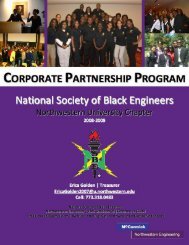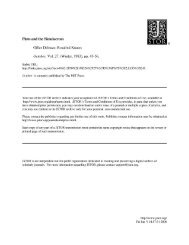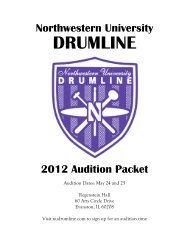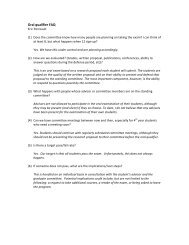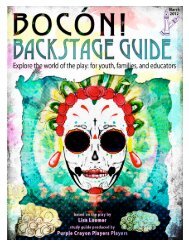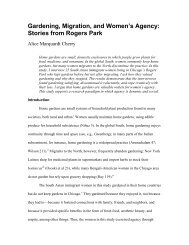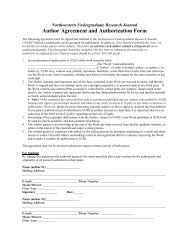research - Associated Student Government, Northwestern University
research - Associated Student Government, Northwestern University
research - Associated Student Government, Northwestern University
Create successful ePaper yourself
Turn your PDF publications into a flip-book with our unique Google optimized e-Paper software.
RESEARCHthat weigh heavily on female business owners, both financiallyand psychologically.As microfinance makes big waves in the internationalcommunity, I was surprised to see that so few womenused microfinance loans to help their businesses. Accordingto Ndèye Fatou, who occasionally uses microfinanceloans, she did not like the short repayment scheduleor the high interest rates:“You can’t take money each time you work — you won’tearn anything. Each month you’re obligated to pay thebank […] And sometimes I take a loan of 2,000,000 to3,000,000 [FCFA] […] too difficult, too difficult […] puttingmoney aside, or making something else, you just can’tdo it. It’s the loans that kill me.”The biggest financial problem for these women wasthat the size of the loans they needed was too big for amicrofinance institution, but too small for a commercialbank. Left in the middle without any resources thesewomen had to find alternative financing methods. Inthe end, Senegal loses since small and medium enterprisesmake up the majority of businesses there. Nicoletold me that“[s]olutions have been found at the institutional level forbig businesses, the problems were solved; solutions havebeen found for microenterprises […] but for the majorityin the middle, nothing has been done, or very little […]very few things have been done in all sectors.”There needs to be a formal solution for businessesin the middle. Based on my <strong>research</strong> most female entrepreneursrely on their networks of family and friends,as well as personal savings, to finance their businesses.In short, a business that aspires to become formally establishedrelies on informal methods of support. Usingtheir own resources, the women have been very successfulin their businesses, but all of the women desire toexpand their companies. The only way to do that is tohave sources of funding that are accessible and availableto their needs.ConclusionAlthough my project was small, I discovered informationthat encourages me to continue this <strong>research</strong>.My initial goal was to compare the profiles of femalebusiness owners with those of male business ownersand decide whether different characteristics amongstmen and women make it easier for women to start businesses.However, my interviews and statistical results donot appear to show much of a difference. Overall, forthe entrepreneurs that I met, education and work experienceplay a major role in starting businesses, and moststart their businesses later in life. Even in finance, bothmen and women struggled to find substantive financialbacking outside of their own means. However, with anew political atmosphere and pro-woman governmentcampaigns, I felt there should have been more financingavailable for women. This was not the case.I plan to do more in-depth studies at women whosucceeded in accessing government funds. Since theVOLUME 7, 2011-2012government has made money available to female businessowners, and since the women I interviewed hadqualifications that would allow them to take a loan,I want to understand who is actually accessing thesegovernment funds and how they succeed in taking theloans. Is it all political, like my interviewees claimed?Or are there other factors playing into the inaccessibilityof the National Funds for the Promotion of FemaleEntrepreneurship? The answers to these questions arenecessary to establish practical resources that enablewomen to create formal, larger-scale businesses and toultimately achieve their goals.Endnotes1 UN Millenium Development Goals. “Goal 3: Promote Gender Equality and EmpowerWomen.” < http://www.un.org/millenniumgoals/gender.shtml>2 CIA World Factbook. 2002 estimates.3 ILO. “From Entrepreneurship to Education: how empowering women can help theirchildren learn.” 4 EUROPA: “Définitions des micros, petites, et moyennes entreprises.” Works ReferencedCentre Africain de l’Entrepreneuriat Féminin. Manuel de Formation sur la Gestion des ActivitésEconomiques des Femmes: Manuel de l’Animatrice. Dakar: CAEF, 2009. Print.Doudou Sarr, Niang. “FONDS NATIONAL DE PROMOTION DE L’ENTREPRENARIAT FÉMININ :1,2 Milliard Pour Aider à l’émergence de Véritables Femmes Chefs d’entreprise.” LeSoleil. Grafisol. Web. 29 Nov. 2010. .Ministère des Petites et Moyennes Entreprises, de l’Entrepreneuriat Féminin et de la Microfinance,and Direction de l’Entrepreneuriat Féminin. Guide de la femme entrepreneure.Dakar: Ministère de PME, de L’Entrepreneuriat Féminin et de la Microfinance, 2006.Print.RBSA WED, and Bureau International du Travail. Diagnostic Institutionnel & Evaluation desBesoins des Associations de Femmes Entrepreneures du Milieu Urbain et Rural et duSecteur Informel. Publication. Dakar: BIT, 2009. Print.InterviewsNdèye. Personal Interview. 6 August 2010.Ndèye Fatou. Personal Interview. 16 August 2010.Nicole. Personal Interview. 6 August 2010.AcknowledgmentsThis project first and foremost would not have been possible without the inspirationand encouragement of Professor Jeff Rice, who pushed me to apply for the summer <strong>research</strong>grants and started me on my way to networking in Dakar. Without the advice and wisdomof Professor Hilarie Lieb, I would have been completely lost in the world of economic field<strong>research</strong>. I would also like to sincerely thank the both of them for vouching for and supportingme during a tough process.I would like to thank Sijh Diagne and Professor Souleymane Bachir Diagne for providingme with local contacts in Dakar and for making sure I wasn’t alone in this project.In Senegal, I owe all my gratitude to the staff of the West African Research Center, SaliouBodiang, Maréme Cissé Thiam of the Direction de l’Entrepreneuriat Féminin, Marie LaetitiaKayisire of the Organisation Internationale de Travail, Charles Fall of the Fonds de PromotionEconomique, Dr. Ndèye Sohka Guèye of Université Chiekh Anta Diop, and Dr. SerigneMoustapha Sene of the Ministère de l’Economie et des Finances. All of these people helpedme connect with the fantastic entrepreneurs I interviewed. I also want to thank Sidy Guèyefor teaching me Wolof, Genia Martinez for keeping me sane, Baye Diasse for helping makemy time in Dakar memorable, and Mame Souka for graciously letting me live in her home.Without help from all of these people, I would have never been able to complete my<strong>research</strong>.To all of the women I met with and who let me hear their stories: I thank you!This project would not have been possible without funding from the Weinberg Schoolof Arts and Sciences and the Program of African Studies.I would also like to thank my parents, who supported me wholeheartedly in thisjourney.NORTHWESTERN UNDERGRADUATE RESEARCH JOURNAL51



